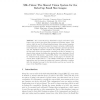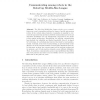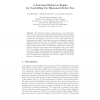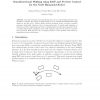ROBOCUP
2009
Springer
14 years 6 months ago
2009
Springer
The current RoboCup Small Size League rules allow every team to set up their own global vision system as a primary sensor. This option, which is used by all participating teams, be...
ROBOCUP
2009
Springer
14 years 6 months ago
2009
Springer
In this paper we describe a new approach to make use of a heterogeneous robot team for the RoboCup Rescue League Virtual Robot competition. We will demonstrate coordinated action b...
ROBOCUP
2009
Springer
14 years 6 months ago
2009
Springer
Abstract. The RoboCup Middle-Size League robotic soccer competitions pose a real cooperation problem for teams of mobile autonomous robots. In the current state-of-practice coopera...
ROBOCUP
2009
Springer
14 years 6 months ago
2009
Springer
As the reach of multiagent reinforcement learning extends to more and more complex tasks, it is likely that the diverse challenges posed by some of these tasks can only be address...
ROBOCUP
2009
Springer
14 years 6 months ago
2009
Springer
In this article, we provide an overview of three humanoid soccer platforms currently in use at RoboCup: 3D simulation, the humanoid Standard Platform League (SPL), and the Webots-b...
ROBOCUP
2009
Springer
14 years 6 months ago
2009
Springer
The high-level decision making process of an autonomous robot can be seen as an hierarchically organised entity, where strategical decisions are made on the topmost layer, while th...
ROBOCUP
2009
Springer
14 years 6 months ago
2009
Springer
In this article a method is proposed for ball tracking using 100 Hz computer vision in a semi-automated foosball table. In this application the behavior of the ball is highly dynam...
ROBOCUP
2009
Springer
14 years 6 months ago
2009
Springer
Fast-paced dynamic environments like robot soccer require highly responsive and dynamic locomotion. We present an implementation of an omnidirectional ZMP-based walk engine for the...
ROBOCUP
2009
Springer
14 years 6 months ago
2009
Springer
ROBOCUP
2009
Springer
14 years 6 months ago
2009
Springer
This paper is focused on the sensor and information fusion techniques used by a robotic soccer team. Due to the fact that the sensor information is affected by noise, and taking in...




